Great Danish Designers 101: Grete Jalk
Grete Jalk worked in an era when female furniture designers were rare. Although once condescendingly referred to as a fine example of “the strong weaker sex,” her talent as a designer was widely recognized and praised. She won major awards soon after completing her studies at the Danish Royal Academy and would go on to enjoy a long and successful career, earning a reputation for innovative designs that were economical in their use of materials and ideal for the “evolving, modern home.” (Pamono, R & Company)
Grete Jalk: Embracing Social and Technological Progress
Grete Jalk was born in Copenhagen in 1920. She studied modern languages and philosophy before enrolling at the Copenhagen Design School for Women. In 1942, she moved onto the Danish Royal Academy where she studied under famed designer Kaare Klint. She completed her education in 1946 and, in the same year, won first prize at the annual Cabinetmakers’ Guild Competition.
Jalk was known for creating “thoughtful designs” that were well adapted to people’s needs and “embraced societal and technological progress.” Perhaps one of the best examples of this progressive mindset was her “self-supporting woman’s den.” Introduced in 1947, it combined a sofa bed, wall-mounted storage space, and desk, and was designed to act as both bedroom and study for professional women. Jalk’s “Watch and Listen” living room unit is another example of a design created for modern lives. Made of pine, it included compartments for a television, stereo system, records and tapes, and a small film projector. Space for speakers was provided at either end. Countering the prevailing trend of the day, the speakers were open to view instead of being placed behind lattice work, signalling Jalk’s intention that the technology be displayed instead of hidden. (Unfortunately, we could not find pictures of either design online.)
In 1951, Jalk attended the Milan Triennale and received wide acclaim for her designs. Two years later, she opened her own design studio. Working under her own name, she designed furniture for major Danish manufacturers, including Poul Jeppesen, Fritz Hansen, Glostrup, and France & Son. Her minimalist designs were, true to her Danish heritage, multifunctional. They included storage units with pull-out seating, day beds with built-in storage, and folding tables that could be tucked away when not needed.
With “clear, comfortable lines,” many of Jalk’s designs were particularly well suited for quick and cost-effective mass production. Interestingly, her most famous design was not. The GJ Chair, which has been described as a “staggering example of postwar design innovation,” was so complicated to create that mass production was not possible. It is estimated that only 300 copies of the chair were made. (Pamono, Retro Obsessions, R & Company)
The GJ, pictured below, was made of molded plywood and teak veneer. Its shape, likened to origami, was achieved through an “intricate process” of bending and laminating. In 2008, Denmark’s Lange Productions was given authorization to create reproductions of the chair, but originals are highly sought after and command high prices. At the time of writing, the chair shown below was priced at $59,000 CAD.
Images from 1stdibs.
The significance of the GJ Chair was immediately recognized. It won first prize in a competition held by the UK’s Daily Mirror newspaper in 1963, the year it was produced. In the same year, the Museum of Modern Art acquired a GJ Chair which is still in its collection today.
While less complex than the GJ, Jalk’s other designs still demonstrate the high level of artistry, utility, and craftsmanship for which Danish mid-century furniture was known.
She created many lounge chairs, including this pair, currently in stock at VHB. The design was notable for its simplicity and comfort, seen in the gently curved armrests and coiled spring seat and back.
Images from VHB.
Her day bed offers a clean, modernist design with a surprise element of practicality: the seat back opens to provide storage.
Images from 1stdibs.
The unit shown below, made of teak, includes a modular bookcase system and two dressers with pull-out seating underneath: a banquette on the right and two stools on the left. The interior of the cabinets includes drawers with oak veneer.
Image from Invaluable.
Also designed with busy modern lives in mind, Jalk’s folding nesting tables and cart. The listing for this set refers to it as an “ingenious solution for sensible storage and elegant entertaining.”
Images from 1stdibs.
Her adjustable stool, shown below, provided a versatile seating option for modern homes. This design was exhibited at the Copenhagen Cabinetmakers’ Guild Exhibition in 1961, an event Jalk participated in nearly every year throughout the 1950s and 1960s.
Image from 1stdibs.
Deceptively simple but highly practical, Jalk’s teak coffee tables often included storage tucked elegantly underneath the tabletop. This Grete Jalk table with slatted shelf was in VHB’s collection but has been sold:
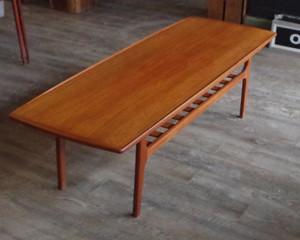
Image from VHB.
Like other designers of the day, Grete Jalk chose to work with a wide range of materials. Her veneer work, seen in the GJ Chair and bookcase shown above, is one example. She also worked with leather and vinyl, metal, and various woods.
In the 1950s, she combined naugahyde and teak, as seen in this lounge chair and ottoman produced by France & Sons:
Image from 1stdibs.
By the 1970s, she was designing leather seating on a curved steel base:
Image from RetroStart.
Like other mid-century designers, Jalk also used leather and leather-like materials in her dining chairs. In the armchair shown below, the black vinyl provides the perfect contrast to the sleek rosewood frame:
Image from 1stdibs.
Using the same materials, Jalk created a very different look, with sharper corners than were seen in the gently curved chair above:
Image from 1stdibs.
As these two starkly different dining chairs show, Jalk was known to experiment with a variety of shapes and angles. The coffee tables shown below incorporate two different structures to achieve the floating look that was so popular in the mid-century period. The first uses dramatically curved legs to create the illusion of space between the legs and rounded tabletop, while the second uses slender dowels to lift the sharply rectangular tabletop from the base.
Image from 1stdibs.
Image from 1stdibs.
Texture and a touch of whimsy also factored into Jalk’s designs, in the form of decorative circles applied to the surface of some of her coffee and side tables. The first is made of rosewood with Bakelite circles; the second is teak with laminate circles:
In addition to designing, Grete Jalk taught at the Danish Royal Academy from 1950 to 1960 and had two six-year tenures as editor of the Danish design magazine Mobilia. In the mid-1970s, the Danish government asked her to curate a travelling exhibition of Danish design, and in 1987 she edited the four-volume book Forty Years of Danish Furniture Design. Grete Jalk passed away in 2006. (Pamono, Retro Obsessions)




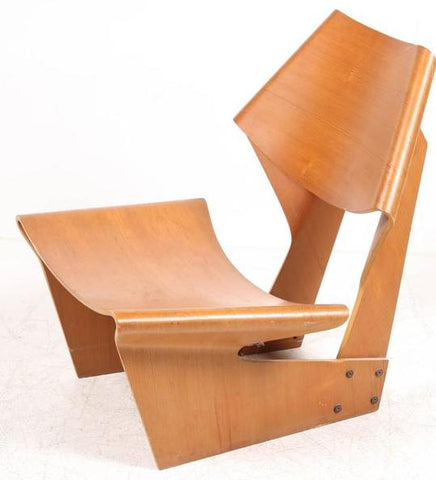

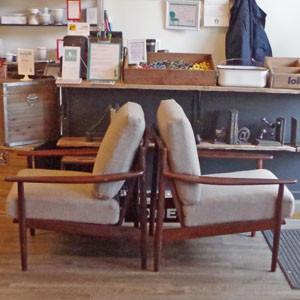
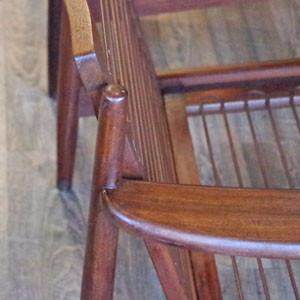
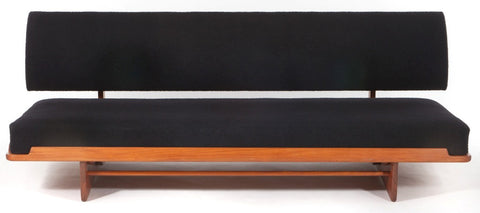
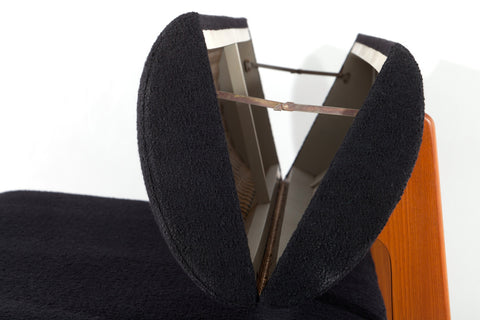

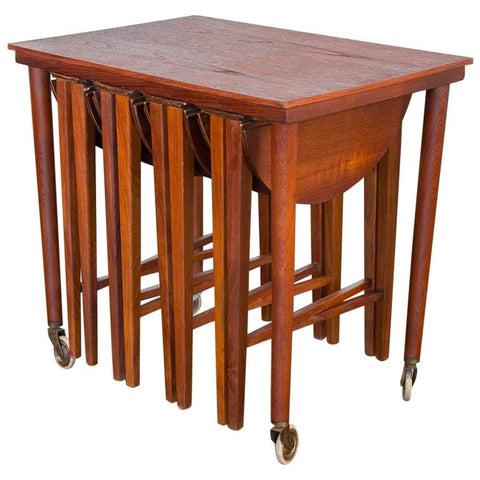
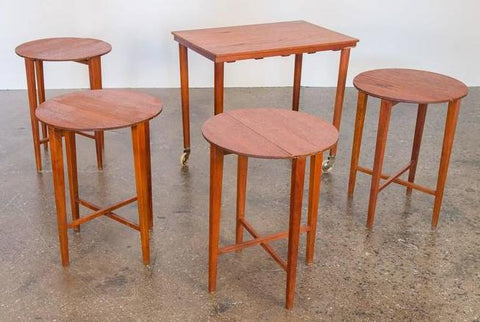

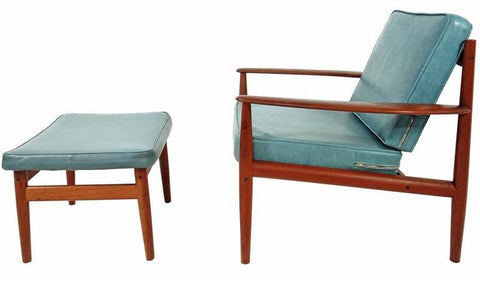
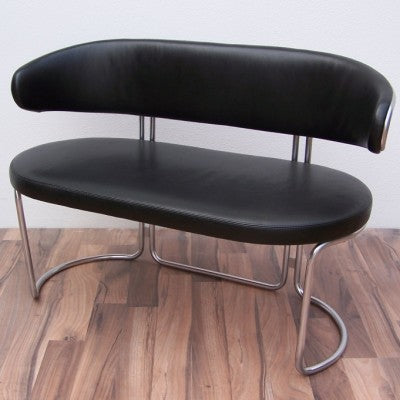



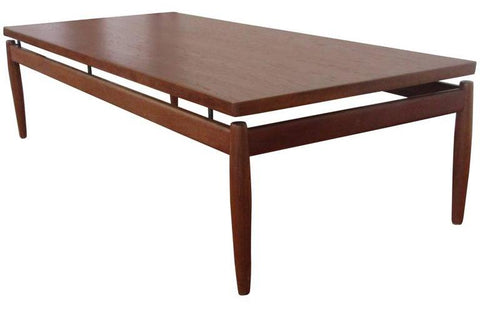

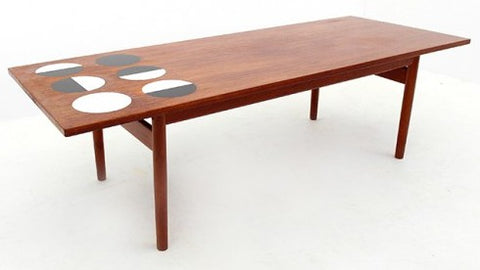
Leave a comment